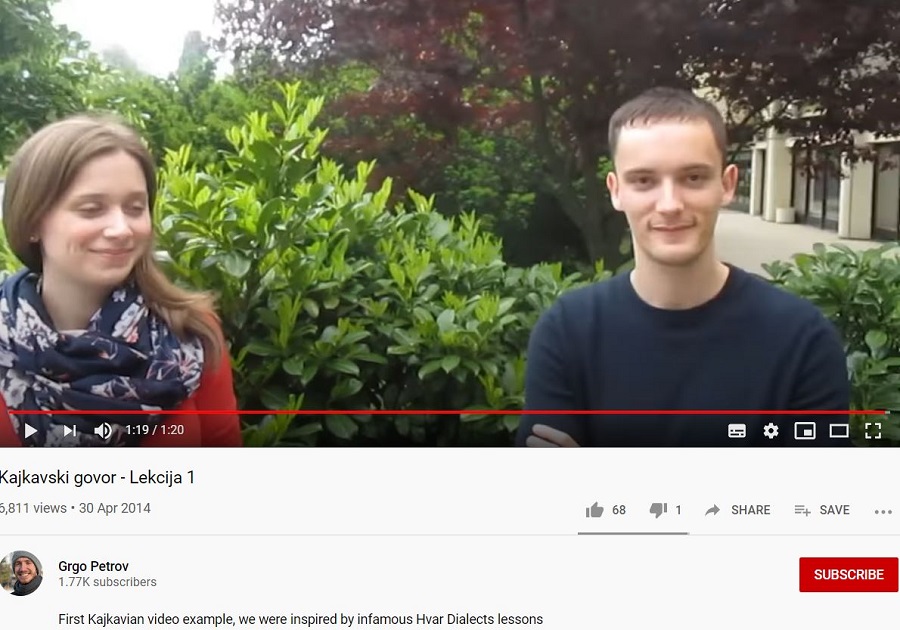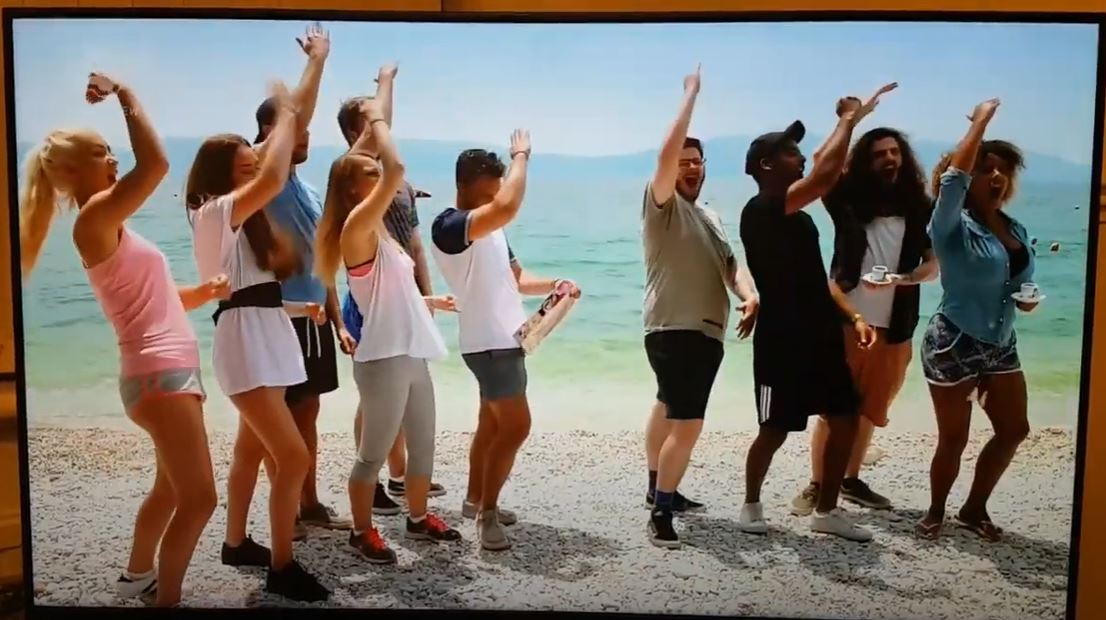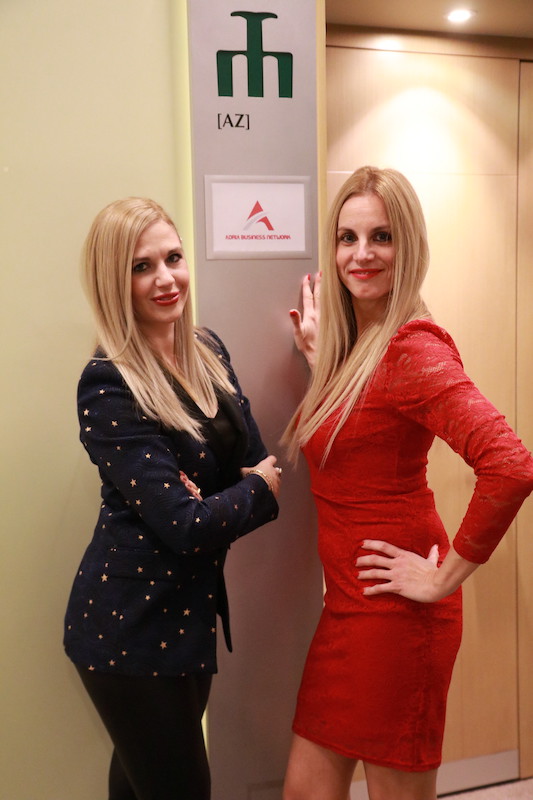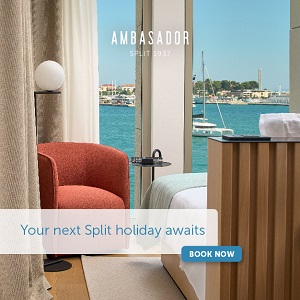Minister of Defense Damir Krsticevic Announces Resignation
May 7, 2020 - An extraordinary press conference of the Ministry of Defense started at 7:45 pm in Zemunik, after a military plane crashed after 4 pm, killing two soldiers. During the press conference, Defense Minister Damir Krsticevic announced his resignation.
Minister of Defense Damir Krsticevic and Armed Forces Chief of the General Staff spoke at the conference concerning the military plane crash, reports Dnevnik.hr.
Admiral Robert Hranj said instructor Lieutenant Marko Novkovic was killed in the crash.
The cause of the crash is still unknown. An investigative commission has been formed. Hranj expressed his condolences to the families.
It was said at the conference that the plane crashed half an hour after takeoff. There were no problems with the plane, and Marko Novkovic was a very experienced pilot.
Minister Damir Krsticevic said that it was very difficult to lose a soldier. He remembered the accident that happened in January in Zablace, where two soldiers also lost their lives. Krsticevic received information about today's accident shortly after 4 pm. He expressed his condolences to the families.
"I received information around 4 pm that an accident had taken place. I immediately went to Zemunik. During the trip, I heard from the president and the prime minister and informed them about this event. It is tough to lose a Croatian soldier, and it is difficult for every defense minister and every commander in the Croatian Army. As we know, three months ago, we had a tragic helicopter accident when we also lost two young lives.
What is important is that everything is investigated, I am talking about the whole system, and the truth must be told and we must be transparent about everything. We are forming a commission with the chief aviation investigator who needs to do a detailed investigation into this event," the minister said.
"I also ordered the Chief of the General Staff to form his own commission to investigate all military circumstances and to look into everything that needs to be investigated," Krsticevic added.
"Our task is to be with families and we will provide all the necessary help and support. Everything we know and can do. As Minister of Defense, I want to express my condolences to all members of the Croatian Air Force and the entire army. This is a huge loss for the Croatian Army. As of today, I am resigning from the position of Deputy Prime Minister and Minister of Defense of the Republic of Croatia," Krsticevic concluded.
To read more about politics in Croatia, follow TCN's dedicated page.
UNESCO Heritage of Croatia: Historical Complex of Split with Palace of Diocletian
May 7, 2020 - After her extensive coverage elsewhere in Croatia, TCN UNESCO correspondent Filipa Marusic returns home for her latest installment - the Historical Complex of Split with Palace of Diocletian.
After all my UNESCO articles, I’m finally writing a piece about the heritage of my hometown Split. The article will take a look into a still standing culture with the history dating back to the 3rd century AD, which makes Split a city which is more than 1700 years old. The article will present all the heritage located in the old town in the centre of Split.
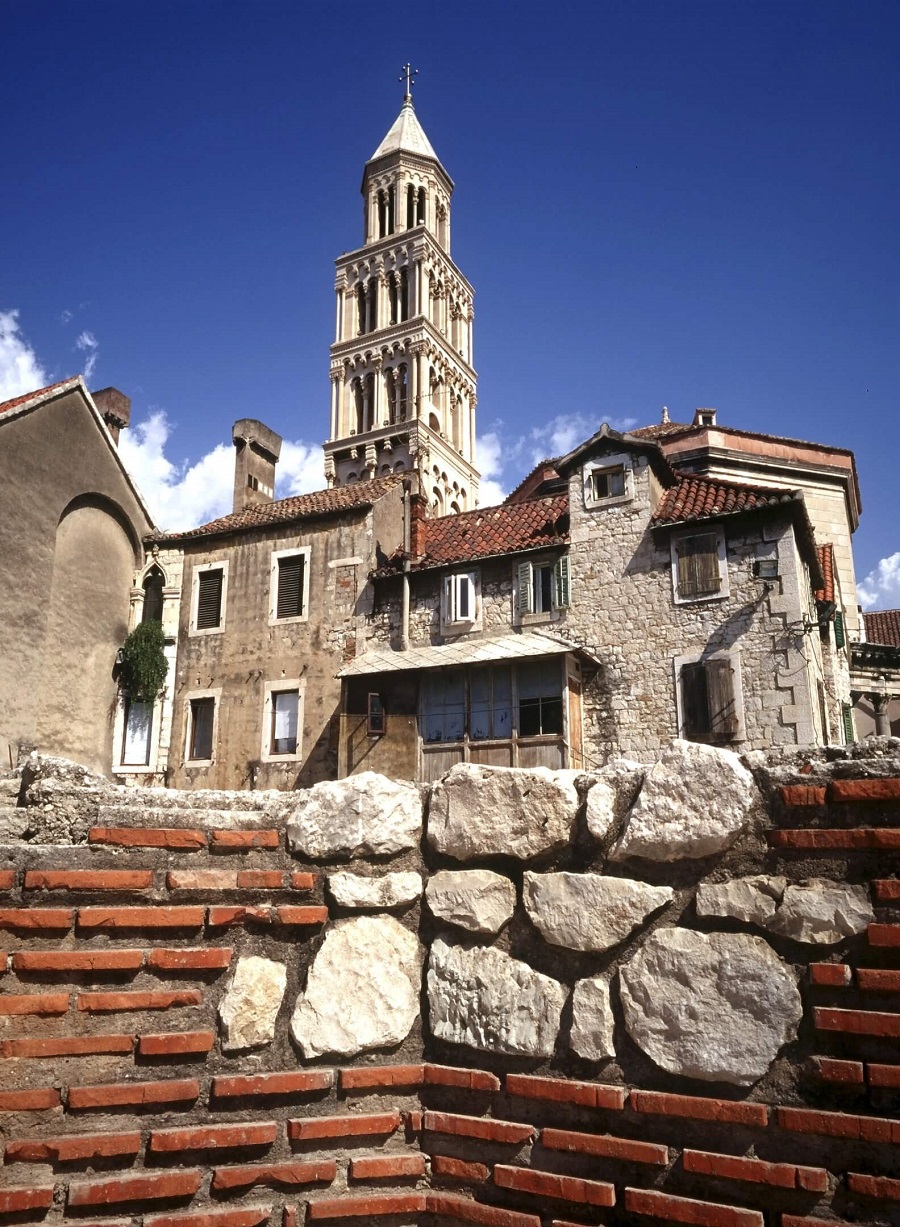
The foundation of the second-largest city in Croatia was a Roman palace built by Emperor Diocletian who decided to spend the last years of his life in Split. Now Split is a big mixture of different architectural, historical, and cultural heritage, a combination of art styles and city with traditions inherited throughout centuries. The Palace of Diocletian and the historical complex of Split have been part of the UNESCO World Heritage list since 1979. The main reason for UNESCO protection is the excellent preservation level of the Palace of Diocletian, as well as the fact that different parts of history are visible in the city structure and were used and reused in the past as well as today. The relatively small old town centre has a different heritage ranging from Roman Palace to Medieval Romanesque churches, Gothic and Renaissance palaces and portals, baroque facades, and modern-day buildings. The historical complex includes the ruins of Diocletian’s Palace built between 295 to 305 as well as Medieval buildings such as the Cathedral tower, 12th and 13th-century Romanesque churches, medieval fortifications, 15th-century Gothic palaces and other palaces in Renaissance and Baroque style. A lot of material from ancient times was reused in building newer structures in the middle ages. Diocletian’s Palace is one of the best-preserved examples of Roman architecture in the world. Along with the historical heritage, Split city centre still has locals living there, as well as tourists who visit seasonally.
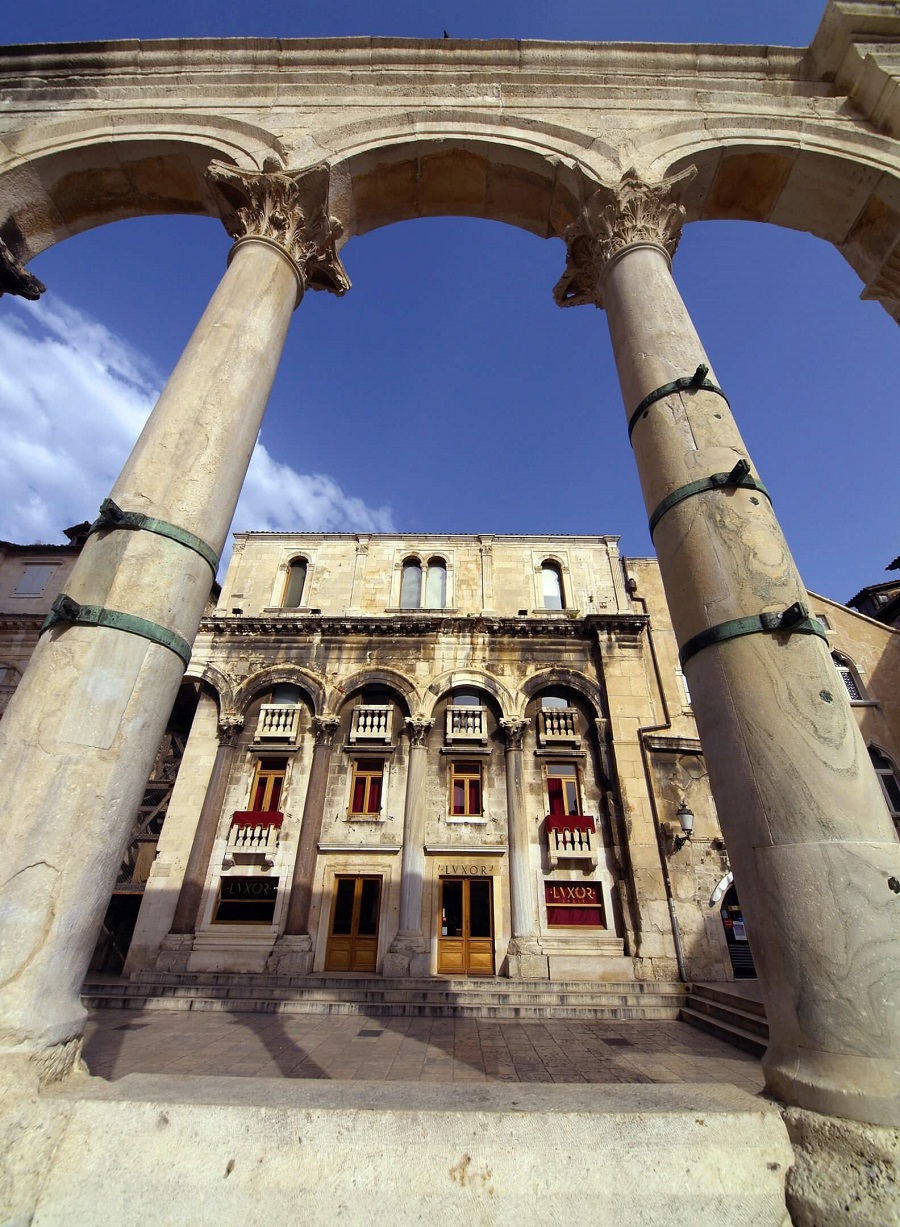
Archaeological findings show that there were even older Illyrian and Greek settlements and even some traces from prehistory before the Palace. Urbanistic development started in the 7th century, after the fall of Salona when local people moved to Diocletian’s Palace and the surrounding area. Split changed different authorities throughout the centuries. It started with Croatian kings in the 10th century, then during Medieval times Split became an autonomous commune. From 1420 to 1797 the city was under direct Venetian rule, while in the 16th and 17th centuries, this area was under attack by the Ottomans. From the end of the 18th century, Split is under Austrian rule and then short French rule during Napoleon times, and then after under the Austro-Hungarian empire where it is part till 1918. From 1918, Split was part of the Kingdom Yugoslavia (SHS). During the Second World War, it was under Italian and German occupation and became one of the centres of antifascist resistance. After the war, it became part of Socialist Yugoslavia and then from the 1991 part of the Republic of Croatia.
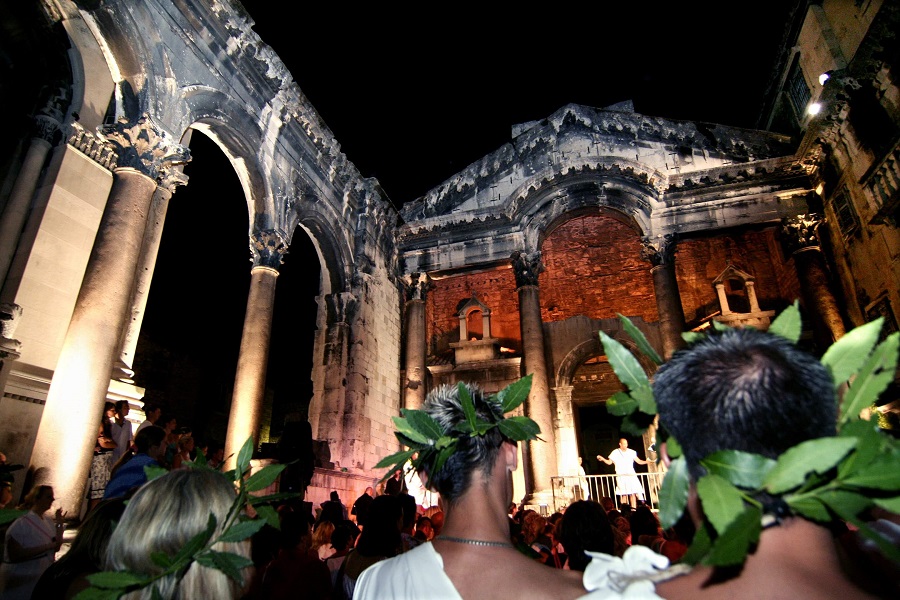
To understand Diocletian’s Palace in Split, we will take a look into the life story of Diocletian. Emperor Diocletian was born in nearby ancient Salona in 243. He became a soldier and rose to military commander and commander of the emperor’s guard. According to legend, one prophet once told Diocletian he would become emperor when he killed a wild boar. When the city perfect called Flavius Aper (aper meaning wild boar) killed emperor Numerian, Diocletian killed him and became emperor in 284. During his 20 year rule, he introduced order, secured the borders, and created a new territorial division of the empire, separated military and local municipality, reorganised the army, finances, and taxes. In 285, he introduced Maximilian as his co-emperor, and in 293, he introduced a new model of a ruling called tetrarchy. He ruled the east part of the empire and had its base in Nicomedia, while Maximillian ruled the west part of the empire – both were Augusts, and each had its substitute Caesars. There were two Caesars, Galerius and Constantius Chlorus – the idea was the Caesars inherit Augusts' place. In 303, he introduced several rules for persecuting Christians and is considered as one of the biggest persecutors of Christians. He abdicated in 305 and moved to Split, and he is remembered as the only Roman emperor who voluntarily abdicated. He did gardening as a hobby and told people of Rome, “If you only knew how good is cabbage here, you would never call me back to Rome.” There is a theory Diocletian had rheumatism, and Split was the perfect place to choose as his residential home as it has several sulphur water springs. He died in 316 and was buried in the mausoleum. The mausoleum is now in use as the Split Cathedral dedicated to St Domnius, one of the victims of its rules against Christians.
Diocletian’s Palace is a combination of a Roman military camp called Castrum, and a luxury villa. The builders were Greeks called Zotikos and Filokos, and it represents a masterpiece of late antique architecture. The Palace of Diocletian is divided into four parts and has two main streets. The size of the Palace is 180 x 215 m. The stone used for the palace building was from the quarry in Seget, from Brač and different parts of the Roman Empire, even from Egypt. Three sides of the Palace were built-in military styles with forts, high walls, and double gates, while the south side was the place for emperors’ apartment decorated with columns and arcades. The emperor’s residence had 68 rooms – the same as the number of the rooms in palace basements. The scheme of both palace levels is the same, and based on well-preserved palace basements, and one can tell what is what in the emperors’ apartment. The lobby of the flat was the Vestibule circular area, and in front of it is Peristyle – the main central place for emperors’ ceremonies and now one of the main squares in central Split. Peristyle square is surrounded by temples – to the east, there is the mausoleum now in use as a cathedral, and to the west, three temples – Cybele temple, Venus temple, and in the middle, Jupiter temple. Peristyle is the intersection of two main streets – Cardo (going south-north) and Decumanus (going east-west). Cardo street leads to Peristyle from the main entrance or North gate. Decumanus divided the Palace in the north path for the staff, military, and stables while the south part for the emperor’s family. These streets were much broader than now and were 12 m wide.
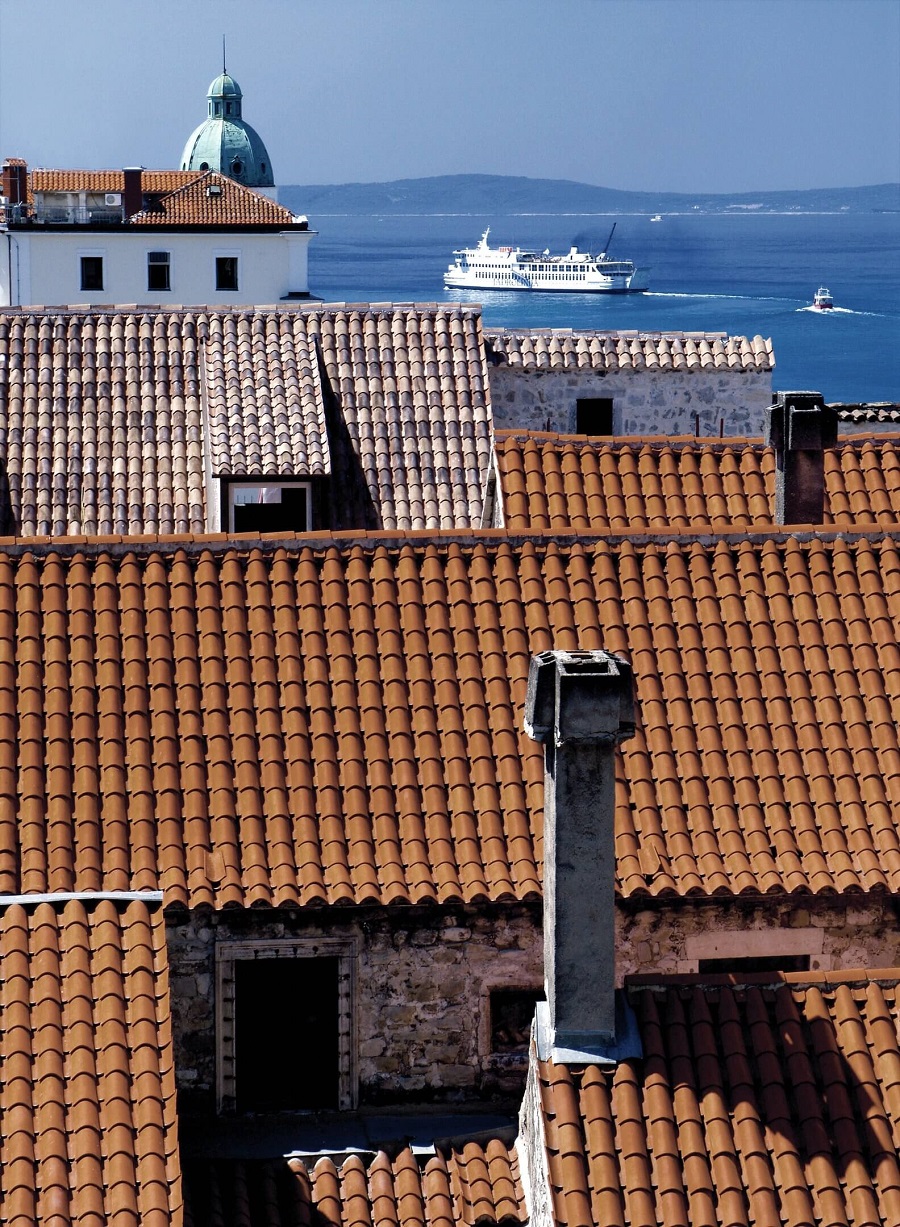
All the outer walls of the Palace are mostly the same apart from the western wall. The south part of the Palace was the only one without towers, and the other palace walls had 16 defence towers, out of which there are just three preserved. The south part of the Palace was more luxurious, and it was elevated with palace substructures to level it up with the north part of the Palace. The front walls of the Palace are large and without any defence towers, while the upper part has large open windows with arches, columns, and wreaths. The emperor’s apartment had a square shape from the outside and circular shape from the inside. The apartment has not really been preserved, but based on the setting of the lower substructure level, one could tell the layout of the rooms. On the west side, there are remains of the hall with a dome, and on the east side, there are the remains of Triclinium - the eight angle dining room with three halls in the shape of a cross. In the southwest are remains of the ancient spa while on the east next to Triclinium is Palace of Emperor's wife and daughter. In this part, there are also two churches built - church of St Andrija de Fenestris – rebuilt ancient sleeping room and St Nicola de Sdoria – rebuilt ancient west hall of the dining room. Today the Ethnographic museum is located right next to the triclinium. The apartment had a long room on the south called cryptoporticus from where there were 42 window openings and three arches with an open view to the sea. In front of the south wall, there was a dock for ships 12 metres wide. This means Split always had some promenade, which is today popularly called Riva.
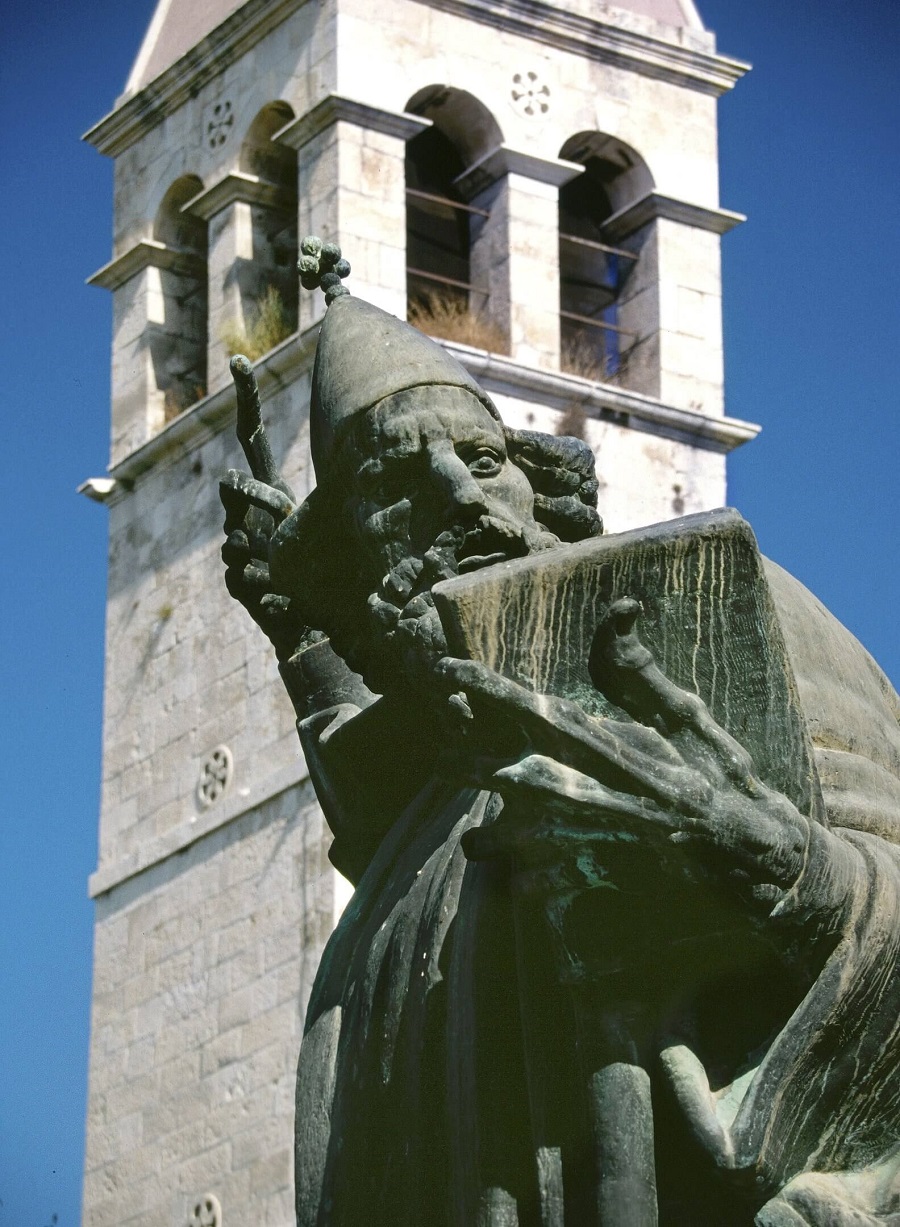
The Palace basements or substructures present a range of halls and rooms and cover one-eighth of the total palace surface. The palace substructures are one of the best-preserved parts of the Diocletian’s Palace and one of the best-preserved examples of Roman architecture from Late Antiquity. The common name for this space is basements or “podrumi.” This is the lower storage for food, oils wine and arms. The primary function was to support and elevate the upper floor where the emperor’s apartment was. Each room in the basement is the same shape as the top floor, and that’s why the palace basement was important for reconstructing the upper part of the Palace. In early Medieval times, the part of the basements was used as a residential area, and one of the halls has elements of an ancient oil and wine press. With people moving outside the basements around the palace area, the basements started to be used as first as storage and then used as junkyard and sewer. Most of the walls and arches are preserved except the wall on the east side of the substructures. These parts offered construction material even for the cathedral's bell tower. Most of the substructure walls are made by using opus quadratum, which is an ancient Roman construction technique where squared blocks of stone of the same height were set in parallel courses, often without the use of mortar. The rediscovery of the substructures started in the 19th century, and it continued in the 20th century in the 1950s. There is about 85% of the total surface rediscovered, and among other findings, there were parts older than Diocletian’s Palace itself. There are different findings, which include water wells in the western part and marble table mensa from Diocletian’s dining halls in the eastern part of the basements. The basements opened to the public in 1959 with the west part, and the east part was opened late as 1996. Today it is fully open for visits and often hosts different events and was one of the filming locations for famous worldwide Game of Thrones show. The central hall is the main passage from Riva promenade and Peristyle square and place to do souvenir shopping.
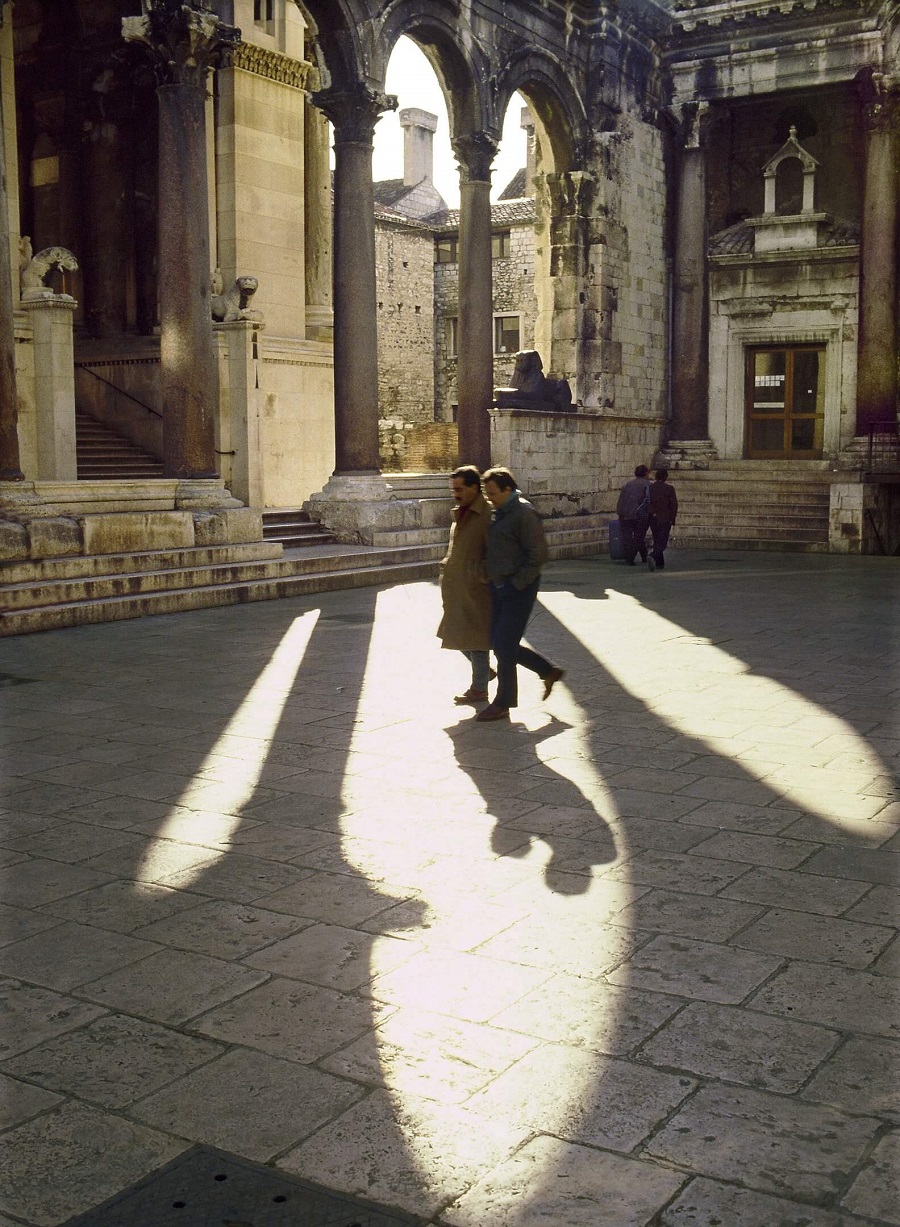
Peristyle is one of the most remarkable places in Split – this was the ceremonial and central place of the Palace decorated with columns. It was intended for Emperor Diocletian to be celebrated as the living son of Jupiter. The Peristyle space is levelled down with three steps in correlation with surrounding streets. This minimised the difference between the height of the south part of the Palace and the lower part on the north. On the south is the entrance to the emperor's apartment, and on the east is the emperor's mausoleum. On the west side, there are three temples – Cybele's temple, Venus temple, and Jupiter's temple. Jupiter's temple was dedicated to the main god of Roman mythology and the divine father of the emperors. Jupiter's temple is rectangular, and it is placed on an elevated podium with a six-column porch. As emperor abdicated, some parts of the temple weren't finished. During late antique and medieval times, the temple was turned into St John baptistery, and the crypt was consecrated to St Thomas. In the 13th century, there was the baptismal font in cross shape placed and made from altar pluteus from the Cathedral. On one of the marble board, there is the oldest image of Croatian king, probably Krešimir IV or King Zvonimir. In inside, there are two sarcophaguses with Split bishops from the 10th and 11th centuries. There is also an Ivan Meštrović statue of St John the Baptist. Barrel coffered vault influenced the early renaissance art of Dalmatia. In the 11th century, there was an early Romanesque tower, which was removed in the 19th century. In front of the temple is one of the partially preserved sphinxes. Next to the temple is the smallest street in the Palace called Let me pass street or "pusti me proć"
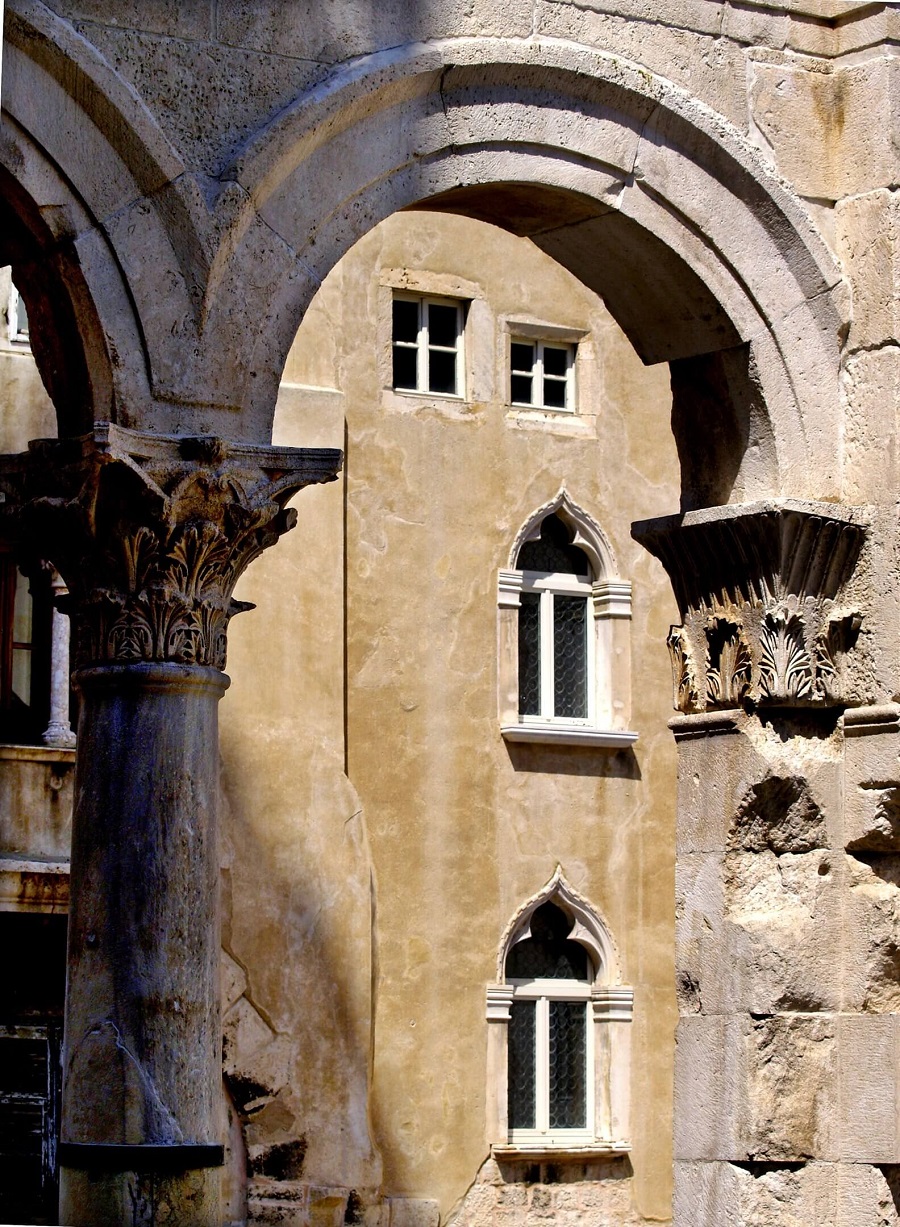
The south side of Peristyle has four columns with Corinthian capitals are the foundation for three-angle tympanums above the semi-circular arch - this monumental entrance to Diocletian's apartment is called Protiron. Between the central columns of Protiron, there is a fenced imperial lodge where Diocletian would appear on special occasions to receive honors from citizens of the Palace and other visitors. These ceremonies were connected to the cult of the emperor, where the emperor showed himself to citizens as a god, and they would probably greet him by kneeling or laying down on the pavement. On top of the Protiron, there was a monumental sculpture – possibly horses in quadriga. In the 16th and 17th centuries, Protiron got two chapels and a central baroque arch. On the east side of Protiron, there is the chapel of Our Lady of Conception from the 16th century, and on the west side of Protiron, there is the chapel of Our Lady of Health or Our Lady of Pojas built as a token of gratitude for rescue from the plague. Left and right from Protiron, there is colonel of six Corinthian columns made of marble and porphyry, which were brought from Egypt. These columns are decorated with wreaths between the arches. The red color of the porphyry columns symbolised the ceremonial function. The entrance to the mausoleum is in between the columns, opposite of the entrance to the Jupiter's temple. In the east part of Peristyle, there is a renaissance church of St Roko, which one of the churches built as church consecrated to saints protects from the plague. In Dalmatia, St Roko and St Sebastian were especial worshiped. People of Split built the church in the 16th century, and it became storage during the renovation of the tower. Today is the location for the info centre of the Split tourist board. And on the west side, there are late-medieval buildings and places Skočibušuć, Cipci (first Split city hall), and Grisogono.
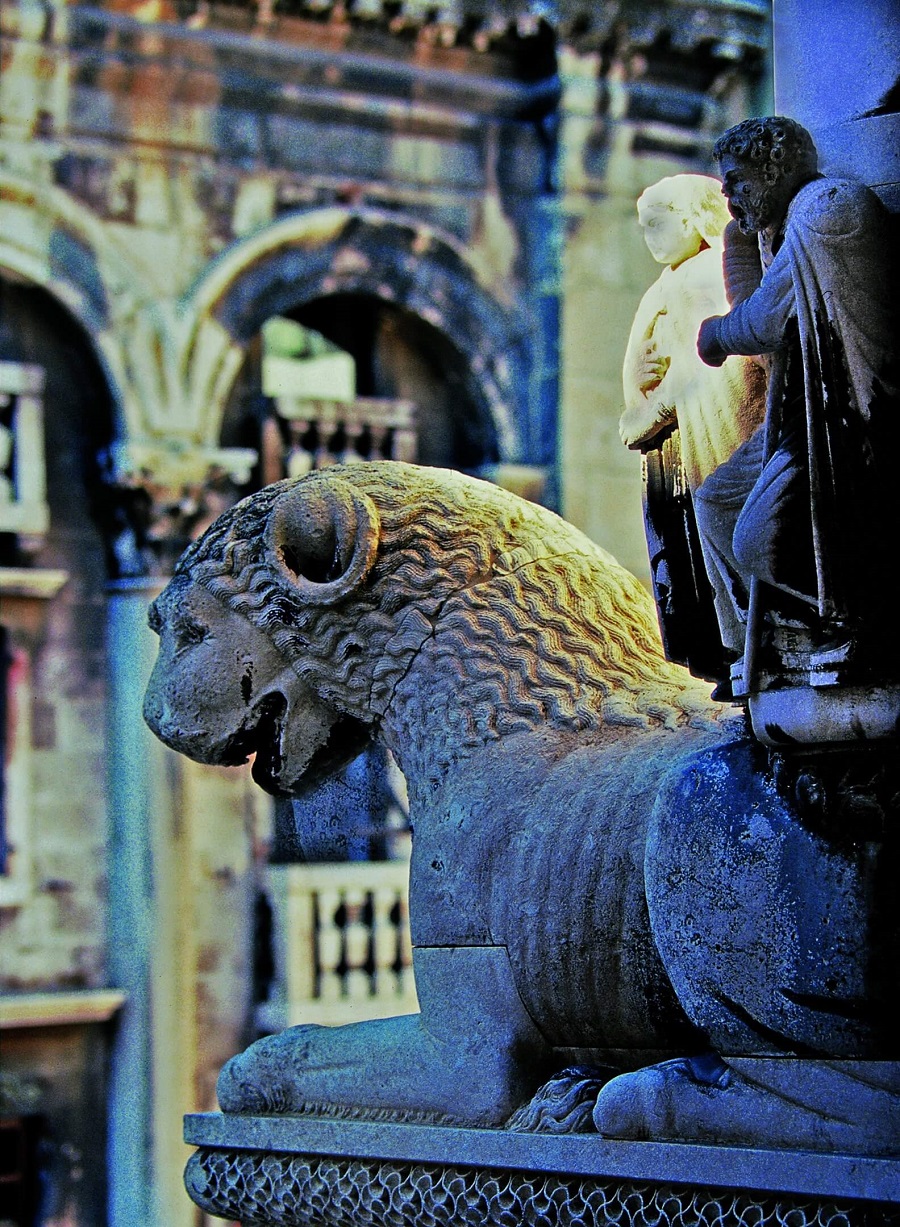
Peristyle is the location for the best-preserved sphinx till today, and there is an assumption there were several sphinxes in front of the temples and mausoleum. All sphinxes date back to the time of Pharaoh Tutmosis III, and there were probably 11 or 12 sphinxes. The Peristyle sphinx is old 3500 years, and it made from black granite. Its paws don't end with ion claws but with human hands holding the sacrificial vase. Medieval people called it Gorgona and were superstitious and avoided any eye contact with this pagan symbol. It is 2,46 meters long, 1m high 0.65 m wide. It was probably one of the four sphinxes guarding the entrance to the mausoleum. The beheaded sphinx in front of Jupiter's temple is also from these times, and it got destroyed as other sphinxes during early Christian times as it symbolised the fight against Christianity. There is one smaller sphinx in the palace substructure and City museum Split. There is one sphinx head on the house in Dominis street. Other fragments are in the Archaeological Museum, City museum Split and Diocletian's basements. Some sphinxes are cut in half, and some are without the head or have destroyed paws and faces. The sphinxes represented the divinity of the emperor, who was also the Egyptian pharaoh.
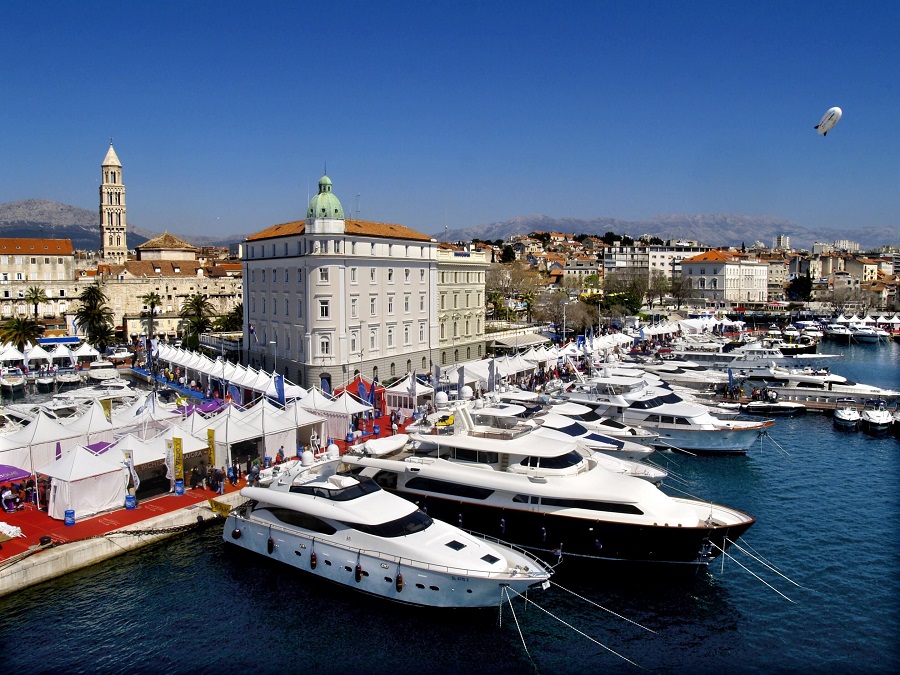
The Vestibule is the hall that connected the Emperors' apartment and Peristyle. The Vestibule is a lobby area before entering the Diocletian's apartment. In four niches, there were probably sculptures of Tetrarchs while today there aren't any. The outer part of this room has a square shape while from inside it is circular – before it had a dome with a mosaic. As this is an acoustic hall, it's today a spot for local klapa signers to entertain tourists and locals.
The mausoleum building became the Split Cathedral, and it is the oldest building in use as a cathedral. The cathedral interior has a mixture of ancient pagan, Christian Medieval, and modern heritage. Mausoleum of the Emperor - the persecutor of Christians, became a cathedral in the 7th century and had altars with relics of St Domnius and St Anastasius, martyrs executed in the nearby Solin. The first bishop of Split Ivan Ravenjanin consecrated the Cathedral to Assumption of Virgin Mary and martyrs St Domnius, St Anastasius, St Kuzma, and St Damjan. It is locally known as the Cathedral of St Dominus, who is a patron saint, and it's celebrated every year on May 7th. The Cathedral is in the central part of Diocletian' Palace, and it is the oldest building in the world in use as a cathedral. The building has an octagonal shape and has covered periptery with 24 marble columns with Corinthian capitals. The portal of the Cathedral was also from ancient times. On the baroque stone board, there is the metropolitan and prime status of the church which archdiocese had until papal bull Locum Beati Petri in 1828. On top of the portal, there is a small sarcophagus - this is the burial site for remains of Katarina and Margarita, the daughters of Bela, the IV who died at Klis in the 13th century. The Cathedral is known for its wooden doors made by local master Andrija Buvina in 1214. The doors have 28 images presenting stories from Christ's life. These doors represented a rare example of well-preserved wooden doors.
The outer octagon of the mausoleum has an aisle (periptery) formed of 24 columns. The Cathedral is from the inside a round shape and is vaulted with a dome with a rectangle and semi-circular niches, which were in ancient times for statues of gods and emperors. The central place in the mausoleum was for Diocletian's sarcophagus, which got destroyed. The inside space is decorated with eight granite columns set on a base of white stone with Corinthian capitals. Above the decorated capitals, there is a wreath with the base for the second row of porphyry columns. Above other capitals, there is smaller wreath and frizz with an image of genius, Mercure Psyhopompos. There are medallions with images of emperor Diocletian and his wife, Prisca. After entering the Cathedral, on the left, there is a six-angle pulpit from the 13th century – it is elevated with six marble columns with capitals from local stone. There are four altars in the Cathedral. The right altar is consecrated to St Domnius, the patron saint, bishop of Salona, and martyr– the author of the altar is Bonino da Milano, and it is from the 15th century designed in late Gothic style. It is the oldest altar in the Cathedral. The left altar, consecrated to city co-patron St Anastasius of Aquileia is the work of Juraj Dalmatinac, who made it in the 15th century – it is made in the shape of the sarcophagus and has realistic relief depicting the Flagellation of Christ. There is a newer altar from the 17th century and another one from the 18th century. The new altar is held by two female statues, symbols of faith and persistence. There are images of angels symbolising victory, and above the altar, there are paintings with images from the Virgin Mary's life. The saints' relics lay in this altar.
The Cathedral has baroque wooden chairs carved in the 13th century and has different images of animals, plants, and geometrical shapes. Between the two-story arcades in the upper part of the seatbacks are depictions of the evangelists and apostles, and on the four ends of the seatbacks, the medieval city patrons of St Dujam and St Anastasius and St. Kuzma and Damian. Particularly impressive is the portrayal of the four priests singing from the open-hearted counter on the counter, which could be explained by a medieval method of "conducting": the rhythm was measured by the heartbeat of the chorister who held his wrist.
The east part of the mausoleum was demolished to expand the Cathedral. The choir was rebuilt in the 17th century. The cathedral treasury is the oldest in Croatia. One of the most important heritage of treasury is the Gospel of St Domnius – the oldest manuscript written on parchment paper preserved in Croatia. Additionally – there are other medieval codex's, matriculas, relevant archive documents, gold pieces, manuscripts like the manuscript of Toma archdeacon Historia Salonitana from the 13th century. St Lucy's crypt is below the cathedral level. There is also a water source, and tradition is to take this water on every St Lucy holiday.
The bell tower construction began in the 13th century and lasted till the mid-16th century. The construction material used was found in Salona. Due to the long period of building, it is a combination of Romanesque and Gothic Style. The tower is a unique architectural work, and it's special due to its slenderness and transparency and its incorporation in the ancient architectural environment. With the use of wreaths and capitals, the tower fits in Peristyle square and its arches and columns. In the 19th century, the restoration process started and lasted until the beginning of the 20th century. The top floor with renaissance elements was changed entirely. Numerous antique spoliae and sculptures of griffin, lions, sphinxes, and people were removed. Some fragments of the old bell tower are in City museum Split or are built-in Tusculum building in Salona. Initially, the tower was 53 m high, and today is 57 m high. You can climb the steps to the top of the bell tower and have a spectacular view of the entire Split.
With the construction of a new city square with the town hall (Pjaca) in the 13th/14th century, Peristyle became a religious centre with the Cathedral as the primary place for liturgy with millennium-long tradition. Today it the central area of Split and location where you can enjoy so many different centuries in history and art. As the heart of the Palace, it has two main streets crossing there lead to the palace entrances. The entrances are the Brass gate on the south, Iron gate on the west, Silver gate in the east, Golden gate on the north – the main palace entrance. These names originate from the 16th century and before they were named based on the side of the world. All three land entrances have a double gating system.
The Brass Gate or in Roman Porta Meridionalis is different from all the other entrances – it was modest in size, and it led to palace Substructures from the seaside. They were considered as secure gates as it ensured one could escape the Palace on the shore in case of attack.
Today they are the busiest gate in the place as its often a starting point for numerous tours. There was a small St Anastasius church built in the 9th century, and it was used until the beginning of the 19th-century after it became a residential house.
The Iron Gate or in Roman Porta Occidentalis is the entrance that was always in use throughout the centuries. The entrance was called free doors or Porta Franche in medieval times as they were only doors that didn't close after the city developed to the west. In that time, "inter ambas portas" or in between double gates was the place for the public courthouse, and it was an asylum for outlaws. As the pavement is higher now, these doors lost their original shape. The west gate had eight angle towers, the same as the Golden and Silver gate. The guards' corridors above the palace gates were transformed into a church in the 6th century. The passage above the Iron gates is consecrated to St Theodor church and the later church of Our Lady of Bell tower with the oldest preserved Romanesque bell tower. The Christianisation of the Palace can be seen at the Iron Gate in the relief of Nika, Roman goddess of Victory, which was reshaped in early Christian cross. Right next to the gate, there is a tower with the 24-digit clock. Today here we have several shops.
The Silver gate, or in Roman the Porta Orientalis, were used to enter the Palace from the east. This entrance was more modest in decorations than the Golden Gate, and it was closed in Medieval times till 1952 and then were reconstructed after Baroque church Dušica was demolished. In the 6th century, the church of St Apolinar was built, and it got destroyed beginning of the 17th century – there aren't any material remains found only on sketches from the 17th century. There are visible remains of the octagonal towers, and now is the place for different open door shops and are closest to Splits' famous Green market.
Golden Gate or in Roman Porta Septemtrionalis was built in the shape of a rectangle, with double doors, as part of the defensive military strategy (propugnaculum). The Golden Gate was the main entrance to the Palace with lavish decorations. In the niches, there were probably figure sculptures of the four tetrarchs (Diocletian, Maximian, Galerius, and Constantius Chlorus), and in the middle was eagle as a symbol of god Jupiter. These doors, starting from Peristyle, and then through Cardo street, led directly towards Salona as the capital city of the Roman Province Dalmatia, and could only be used by the emperor and the members of his family. These gates were closed during medieval times. As part of the Golden gate, there is the church of St Martin, probably built in the 6th century. The St Martin church changed several times, and today, it is restored to the original look with pre-Romanesque marble altar partition from the 11th century, which is in the same place. St Martin is the smallest church in Split and an excellent example of preserved church interior and site for the female Dominican monastery. Today the Golden Gate is one of the best-known spots in Split.
The North facade of Diocletian' Palace and its north wall is 170 m long and has Golden gate in the middle and square tower on each end. From all previous eight angle towers, there are remains. The walls here are simpler, and this was the main entrance to the Cathedral. There were several other objects built around the golden gate – like St Euphemia church, the Benedictine monastery of St Mary, later on, military hospital, from which there is St Arnir cathedral, tower, and the remains of floor plan.
The statue of Gregory of Nin is one of the best-known sights in Split. He was a historical figure who fought in the 10th century for liturgy in the local language – Croatian and the use of Glagolitic letters. The pope abolished the Nin diocese, and the official language of the liturgy was Latin, which was supported by the Split archdiocese, but they still served masses in old Slavic language as a lot of priests didn't know Latin. Famous Croatian sculptor Ivan Meštrović built the statue - the statue was originally in front of the Cathedral. During the second world war, Italian occupiers had it removed and cut in pieces. During the 50ies of the 20th century is restored and places on its current location – this well-known lucky charm of Split – everyone should rub its golden toe for good luck.
On the side of the west wall of the Palace, there is Bosanska street now place for numerous souvenirs shops and shops originally. The top of Bosanska street was the main entrance to the old city. The street got its name after a lot of Bosnian merchants who were there during the 17th and 18th centuries. From there, you can turn to the so-called Jewish passage and go to a Split synagogue built in the 16th century, which makes it the third oldest synagogue in Europe.
Pjaca or Narodni trg is the place you will reach at the end of Bosnian street. This square was previously St Lawrence cemetery, and it became a municipal centre in the 14th and 15th centuries when the communal building was built in the style of Venetian gothic – it included the duke's palace, jail, communal palace, and city loggia which later became the city hall. Old city hall is only preserved building from the late gothic range of building from the 15th century, which was torn down in the 19th century. It has an original appearance on the ground floor. The city hall was connected with Karepić palace and St Lawrence church used by the duke. On the east side of the square is the Iron gate and already mentioned city clock with 24 digits as well as the beautiful Palace Cipriani Benedetti decorated with two six arched windows and statue of St. Anthony the Hermit. On the south side there is the renaissance palace Pavlović and on the west, there is the art deco house Nakić. Pjaca square has always been the centre of city municipality and centre of everyday life, and it still is.
Voćni trg or fruit square is located south from the Pjaca – on the south. There is a Venetian tower from the 15th century built as accommodation for Venetian crew and defence. On the north, there is the baroque palace Milesi from the 18th century and on the square central position is for the statue of Marko Marulić – the father of Croatian literature, again work by Ivan Meštrović. The square was the space for fruit trade till the mid-20th century, and that's why it's called fruit square.
There are numerous small churches and chapels scattered around the city – some are demolished during the time, and for some, we can find remains – the article already mentioned several churches in the old town centre. Also, Split was fortified during the 17th century and had five baroque fortifications called Cornaro, Corner, Priuli, Bernardi, and Contarini connected with walls. Some parts of fortifications were used during French rule for decoration Riva promenade and Marmont street.
The City museum of Split, which keeps a lot of valuable heritage, is located in Papalić palace. This Gothic-Renaissance palace made by Juraj Dalmatinac is the home for ancient stone monuments since the end of the 15th and beginning of the 16th century. The family Papalić had a collection of ancient stone monuments from Salona. Dmine Papalić and Marko Marulić (born in the same street as the Papalić palace) were researching findings in Salona and brought ancient inscriptions to the courtyard of the palace. The city museum opened in 1946, and the first director was Marko Uvodić, who is author of numerous stories and chronicler of life in Split. The museum has several different collections, and it is a good starting point to discover the centuries-long history of Split.
Over the centuries, the palace inhabitants and later the citizens of Split adapted parts of the Palace for their requirements. The interior of the Palace, as well as the exterior walls, changed throughout the centuries. Even with all the changes, the outlines of the Palace are still visible. Split changed a lot with different cultures living there and sharing their ways of living and building. Today we have all this heritage as proof of centuries-long life in the city.
SOURCE (text and photos): UNESCO, Visit Split – Split Tourist Board, City museum Split
Milanović Reacts to Orban’s Map of Greater Hungary
ZAGREB, May 7, 2020 - President Zoran Milanović has told Croatian fourth-grade secondary school students ahead of school leaving exams to learn from history but to look to the future, thus responding to the publication of a historical map of the so-called Great Hungary on the Facebook page of Hungarian Prime Minister Viktor Orban.
Writing in a Facebook post on Thursday, Milanović said that most European countries had in their closets historical maps showing them bigger than they are today, but they are unachievable and they always irritate the neighbours.
Orban has been extending best wishes to Hungarian students ahead of school leaving exams for several days now, and on Wednesday, before a history exam, he published a historical map of Hungary that includes portions of Croatian territory.
"Following the publication of the map/globe showing a hypertrophied Hungary, otherwise our neighbour and, in recent history, a friend which is currently in the firm grip of chronic 'map addicts', here is my message of encouragement to Croatian students ahead of their school leaving exams: Croatia is a modern European state and nation. In our closets and archives there are many historical maps that show our country much bigger than it is today," the president said.
"Closets in most European countries keep similar contents hidden," he added, calling on young people not to share them on their social media accounts. "They are not topical or achievable and, more importantly, they profoundly irritate our neighbours in pretty much the same way as we are irritated and surprised every time by maps that occasionally and predictably emerge like a dark fetish from the pages of some 'leaders' in our neighbourhood."
Milanović called such moves "provocations by those who know well that such maps will continue to remain in the closets."
"Learn from history, but look to the future," he told Croatian students.
More news about relations between Croatia and Hungary can be found in the Politics section.
Revised 2020 Budget Reduces Revenues to 122 Billion Kuna
ZAGREB, May 7, 2020 - The government on Thursday sent to parliament a draft 2020 budget revision which reduces revenues by HRK 23.2 billion to almost HRK 122 billion and keeps expenditures at HRK 147.3 billion.
Speaking at a cabinet meeting, Finance Minister Zdravko Marić said the revised budget was appropriate to the current circumstances and that it ensured the functioning of the state and all its institutions and systems.
Under the revised budget, revenues are planned at HRK 121.95 billion, down from the originally planned HRK 145.1 billion. This decline is a result of bailout measures in dealing with the COVID-19 - the partial or full exemption from income and profit tax as well as contribution payments for businesses affected by the crisis - and of the economic downturn.
Last week the government projected that this year GDP will decrease by 9.4%. The 2020 budget was drawn up with a 2.5% growth projection.
Marić said that until the end of March, the revenues side showed no or little effects of the coronavirus crisis and that the fall was felt in mid-April. In the first two weeks, VAT revenues not only decreased but were negative.
The situation improved by the end of the month and April saw a 43.2% annual drop of tax revenues, while contributions dropped by 20%, Marić said.
Under the revised budget, tax revenues are planned in the amount of HRK 66 billion, HRK 18.1 billion less than in the original 2020 budget.
Marič said the strongest message of the revised budget was keeping expenditures at HRK 147.3 billion despite an unplanned HRK 7 billion for keeping jobs and millions in additional expenses for healthcare.
The focus in this short term is solely on the state's necessary expenses, he said, adding that the EU had helped to keep budgetary expenditures as originally planned thanks to a more flexible approach regarding contracted and allocated funds.
The original 2020 budget was almost balanced but the revision envisages a deficit of HRK 25.3 billion or 7% of GDP. The public debt-to-GDP ratio is planned to increase by 13.5 percentage points to 86.7% of GDP.
Marić recalled that in February the government issued three bond tranches totalling HRK 15 billion and, recently, a seven-year bond on the domestic market worth €1.445 billion as well as refinancing a HRK 7.8 billion treasury bill due today.
Marić said that in the weeks ahead the government planned to issue bonds worth €1.25 billion on the international market and a domestic bond in several tranches as well as utilise EU funds and borrow from international financial institutions.
The budgets of all ministries have been cut with the exception of the Labour and Pension System Ministry, whose budget was increased by HRK 4.75 billion to HRK 53.8 billion, the Health Ministry, whose budget was increased by HRK 93.7 million to HRK 12.5 billion, and the Agriculture Ministry, whose budget was increased by HRK 47.5 million to HRK 7.46 billion.
More budget news can be found in the Business section.
Government to Give 20,000 kuna per Household as Post-Quake Emergency Aid
ZAGREB, May 7, 2020 - The Croatian government has secured emergency aid in the amount of HRK 20,000 per household for the necessary protection and repair of buildings damaged in the March 22 quake that hit Zagreb and its environs, and it will soon put to public consultation a bill on the reconstruction of buildings.
The aid to be granted as emergency relief to households amounts to HRK 141 million in total, it was said at a government meeting on Thursday.
Prime Minister Andrej Plenković asked the competent ministries to finalise a bill on the reconstruction of buildings damaged in the March 22 quake, saying that once the bill was consolidated, a final meeting would be held with representatives of the Zagreb city authorities, after which the bill would be put to brief public consultation and then forwarded to the parliament.
The government wants the bill to be good and comprehensive, Plenković said, noting that the damage caused by the quake was extensive.
Croatia will seek assistance from the EU as well, and PM Plenković said that Croatia would also seek "broader international arrangements, considering the scope of the damage."
The Construction and Physical Planning Ministry has been cooperating with the Regional Development and EU Funds Ministry on preparing the necessary documentation.
"The reconstruction process will last for years, notably the restoration of protected cultural monuments, Zagreb's symbols, but people who have been left without a roof over their head cannot wait that long. That is why it is important to make them feel safe again, provide accommodation for those who will not be able to return to their houses and flats so soon and secure the basic living conditions for them," said Construction and Physical Planning Minister Predrag Štromar.
The government today also made a decision to send financial aid for the global fight against the coronavirus in the amount of one million euros, pledged at an international conference in Brussels on May 4.
It also forwarded to the parliament a bill on the national allowance for elderly people, which proposes that as of January 1, 2021 the national pension for people over the age of 65 who have had uninterrupted residence in Croatia for 20 years, do not have a pension and are not employed, should amount to HRK 800 (slightly more than €100).
The government also adopted a national report on the rule of law in Croatia for the purpose of making an annual European Commission report on the rule of law in EU member states.
This is a new EC mechanism, it is being done for the first time, PM Plenković said, adding that several ministries had cooperated on making the report.
More news about the earthquake can be found in the Lifestyle section.
Croatian Researcher Đikić Claims Team Found Coronavirus's 'Achilles Heal'
May 7, 2020 — A prominent Croatian scientist at a German research institute claims his team discovered the coronavirus's "Achilles Heel", an enzyme which guides its reproduction. The findings could pave the way for a potential cure.
Ivan Đikić said his team at the Institute of Biochemistry in Frankfurt discovered which enzymes help the coronavirus's reproduction, offering a target for drugmakers that could stop the virus's spread while also aiding the body's own immune response to COVID-19.
"We are very excited to discover the secret of this virus," Đikić said in an interview with Dnevnik.hr.
His research indicates the "PLpro" protein helps the virus infect other cells in order to multiply, while also suppressing the body's immune response. The professor at Goethe University said the information could be used to create a "double therapy".
"On the one hand, we destroy the virus in human cells, and on the other hand human cells stimulate the antiviral response by destroying those viruses that are still present in the body," he said. "We are the first with a possible cure."
The method remains untested, according to Đikić, adding the usual caveats before suggesting the discovery was a huge step towards a possible cure.
Focusing on #CoV-2 essential protease we found that inhibition of PLpro blocks viral spread and empowers host anti-viral responses.?A remarkable team effort, detailed study, inspirational, the best experience in my career. ?????#COVID19, #SARS_COV_2https://t.co/4rlziVXS64
— Ivan Đikić (@iDikic2) May 6, 2020
The American Academy of Arts and Sciences member studies the proteins which guide living cells, and how their degradation and disposal over time can lead to illnesses such as cancer and inflammation. Later, he used the same theories to study immune response.
Đikić has joined other prominent Croatian scientists in taking a public, active role in cheering on Croatia's response to COVID-19 and putting the weight of the scientific community behind policy decisions.
The team's work began in early March. The Institute scrapped all other projects and devoted all its resources toward the COVID-19 pandemic, Đikić said.
"We can't succeed in treating COVID-19 if we don't know anything about the coronavirus," he said.
The molecular biologist tasked his team with finding the virus's biochemical weakness, hoping to draw a clearer course towards a cure.
Many ongoing trials are using existing drugs chosen with some educated guessing and a dash of hope. Đikić's team thinks their discovery can help guide researchers in which drugs they use.
His team first scanned all the coronavirus enzymes, after which they focused on one. "Within two months, with enthusiasm, hard work and complete focus, and collaboration with nine laboratories from Germany and the Netherlands, we were able to uncover the secret where the virus is weak," Đikić said.
But all the hard work must create some material benefit. Đikić coincidentally read an article in the journal Science of a clinical trial in New York which may inhibit the very enzyme his team discovered. His fingers are crossed, hoping it works.
"If it is, then we have a boom, we have two great discoveries," he said.
If the drug does not act on the enzyme, the search for a new drug could take six to 12 months, Đikić said.
The novelty and speed of Đikić's discovery could shift how novel viruses are treated — if it works.
"It may take us a long time, but it will be huge for the future. Not only for this virus but also for new viruses," he said.
Despite his high hopes, Đikić still said a vaccine is the only real way to end the global fight against COVID-19.
"While we do not have a vaccine, we must do everything we can to try to find a cure that will help spread the virus more slowly, make people less symptomatic, and protect vulnerable groups," he said.
How the Professor of Hvar Dialects Helped Preserve Croatian Culture & Tradition
May 7, 2020 - What a lovely email! How a fun YouTube series in the early days of TCN became a national phenomenon. It is all thanks to Professor Frank John Dubokovich, Guardian of the Hvar Dialects.
It started out as a joke, something to fill some content in the first month of my new portal, Total Hvar, way back in November 2011. It became such a cult hit that it soon hit national television, then British reality TV, and now - so I learned today 8.5 years later, a catalyst to preserve some of Croatia's dying culture forever.
My good friend from Jelsa, Frank John Dubokovich, was born in New Zealand but moved back to Jelsa at the age of 8, the Hvar town where his family are from. So he grew up bilingual, actually trilingual.
For Frankie spoke Jelsa dialect, which is a whole linguistic sub-species of its own.
An idea was born, to do a short video series of the differences between Jelsa dialect and standard Croatian, looking at different aspects of life - food, months of the year, articles of clothing - to demonstrate the differences. It started with the infamous Dalmatian Grunt, a video which is sadly no longer available online currently (but which I am trying to find), and which amassed almost 100,000 views on YouTube when I saw it last year.
As his flock grew, so did Frankie's authority, and he became the self-styled Professor Frank John Dubokovich, Guardian of the Hvar Dialects. Here is one of the original lessons, in which he investigates parts of the body in Hvar dialect, including a live demonstration of shaking his ass.
His fan base was truly international. The then assistant coach of the Australian football team jetted in from Sydney to meet with The Professor.
So impressed was Ante Milicic with The Professor that he even had his voice on his ring tone and wake up call.
It was only a matter of time before national television came calling.
HRT asked us to record a special lesson on dialect words for wine, which featured on their promo video 'Susur' in July, 2015. The Professor makes his entrance at 04:18 in the programme, above.
With such colossal talent, it was not long before the international talent scouts were in touch with TCN, and The Professor and his Hvar dialects were soon starring on British television reality shows.
How to get a bunch of chavs into Dalmatian grunting - genius!
So brilliant was The Professor that he even taught us how to speak Hvar dialect using only vowels on a guest appearance in Split.
And that is where I thought the story ended. A lot of fun on the way, and a lot of beautiful women falling at The Professor's feet, and the occasional Australian football coach waking up to the dulcet tones of The Professor each morning.
Until today.
Until the loveliest email of the year.
From Grgo.
Hey Paul! We haven't met in person but you've had a huge influence on me and what I have been doing last couple of years. It took me long time to finally contact you haha.
I want to thank you for the Hvar Dialect Lessons you started posting on YouTube 5-6 years ago. I was in shock, just like the rest of my friends from Zagreb and the area. It was super entertaining but also educational. It made me think (and the rest of us) how our authentic local heritage was fading away. General unawareness of this local universe we have across Croatia.
What happened next is I started recording the "Kajkavski lessons of Marija Bistrica" on YouTube with my local native speaker...in the end I spent most of my University along with my master project all about preserving and promoting local dialects and values in Croatia.
I graduated as a visual communications designer so I wrote and illustrated a tale in Kajkavski idiom, then posters and picture books for children...
Following that I started recording other people along the coast. Just last year spent two weeks on Dugi otok island recording the locals stories and their dialects. The project started connecting the locals across Croatia raising awareness. Schools and parents are calling me for the presentations... it's just crazy.
And all of it kind of started when I saw the first "Hvar Dialect Lesson" you posted. ?
Cheers from Zagreb!
Grgo
Love it. And so will Professor Frank John Dubokovich, Guardian of the Hvar Dialects, when he learns that we will be taking him all the way to Marija Bistrica to meet Grgo and do a Mother of All Dialects lesson when all this madness is over.
I can't wait, even though I probably won't understand a word.
Professor, we salute you. Your infamous grunt has inspired the preservation of more Croatian culture that the uhljebs in the ministry in an entire mandate.
I can't wait to hear how the grunt sounds in Marija Bistrica.
You can follow Grgo's excellent YouTube channel here.
Croatia and China Engage in Mask Diplomacy, but Who Benefits?
May 7, 2020 - TCN is delighted to welcome Courtney Long to the writing team. With a BA in Asian studies and currently studying Mandarin in Zagreb, some thoughts on the relationship between Croatia and China. Welcome, Number 151!
Last month, a majority of European nations agreed to implement strict quarantine measures to contain the spread of COVID-19.
The decision reflects a worldwide movement intended to reduce the COVID-19 infection rate. As of this writing, there were already 1,436,617 patient cases across Europe and 139,586 deaths, according to recent reports from Worldmeter’s COVID-19 data. In Croatia, there have been 2,088 infected patients as of May 3rd and the death toll is now at 77.
A TCN article published on Monday, April 13th 2020 explained that Croatia has recently obtained 12.5 tonnes of protective equipment from China. This procurement is the result of an agreement made between Prime Minister Andrej Plenković and Chinese Premier Li Keqiang.
On its surface, this act of cooperation between countries during a global pandemic seems encouraging. In a crisis, we are much stronger as a united force than we are as divided nations who cast blame on each other. Unfortunately, mutual cooperation can only succeed as long as the international cooperating partners are honest and forthcoming with the information they have.
Sadly, this has not been the case with China. We now know that the government of Xi Jinping threatened both Chinese medical professionals and citizens, insisting that they remain silent about their knowledge of the Corona virus, its origins, and the circumstances surrounding the initial outbreak. This insistence on secrecy and the related citizen detentions and interrogations by the CCP led directly to the situation in which we currently find ourselves – one that is proving to be both socially and economically devastating.
Chinese citizens who defied the authorities and exposed what they knew to anyone who would listen have now disappeared, and news organizations from around the world have enquired about the whereabouts of whistle-blowers, some of the most notable being Dr. Ai Fen and citizen journalists Li Zehua, Chen Qiushi, and Fang Bin. To date, these people’s families and friends are uncertain of their respective fates.
It appears now that Mr. Xi and the CCP are trying to worm their way back into the international community’s good graces by practicing “mask diplomacy” – an organized initiative involving the donation (or in some cases the sale) of Chinese medical supplies to the many nations affected by the Wuhan virus. Recent reports have revealed that the Dutch government has recalled 600,000 facemasks from China for being defective, and other European nations are facing similar problems.
China’s Ministry of Foreign Affairs responded to Europe’s complaints with a tweet, stating that recipients should have double-checked the orders before placing them. This is an arrogant and bald-faced addition of insult to injury, and it begs the question why Europe’s politicians, including Mr. Plenkovic, would choose to accept medical supplies from China under these circumstances.
It appears that not only is accepting – or in worse cases, purchasing – medical supplies from China a risk with very little return on investment, but also that the countries who negotiated for the delivery of Chinese medical supplies are learning the meaning of “buyer beware.” India obtained personal protection equipment (PPE) from China and, like Europe, found that it had been given faulty supplies that failed quality testing. According to a recent news report in India, “the term ‘Made in China’ is used [there] as a synonym for defective products.”
Meanwhile in the UK, government officials are scrambling to reclaim the £16 million they spent purchasing Chinese test kits that are now known to give inaccurate results. It’s puzzling to consider that each of these countries has willingly turned to China for a hand-out, with predictable results.
For Croatia, maintaining amicable relations with the Chinese government may be viewed as a practical strategy for now, especially as China is helping this country to construct the Pelješac Bridge. But our government must ask itself what price is to be imposed on it – and on all Croatians – as a result of its willingness to compromise basic standards of justice and decency.
Ideally, Croatia and China will continue to have a mutually beneficial partnership. However, as WION news reporter Palki Sharma observed, now that social distancing is in effect, perhaps it’s time for the world to practice economic distancing with China. Knowing that Wuhan’s wet markets are one again open for business, one could guess either that the CCP has learned nothing from this calamity or that it simply doesn’t care. With this in mind, now may be the time for other nations, including Croatia, to focus on redeveloping their domestic markets, instead of relying on one country with a monopoly on production.
Croatia has openly (and repeatedly) expressed frustration over the struggle to keep its own citizens in their home country, yet this crisis could present the perfect opportunity to incentivize unity among Croatians by engaging them in creating and distributing their own medical supplies, as well as other products, rather than relying on China as a ubiquitous crutch.
Economies around the world are anticipating a depression, and Croatia’s heavy dependence on revenue from tourism has left many people worried about the devastating consequences the pandemic is likely to have on travel. Unfortunately, Croatia’s pride in its coast has given it a case of tunnel vision, resulting in focused investment in the tourist sector at the expense of other industries. Croatia has put most of its eggs into one basket, and now it’s panicking. However, with every crisis there is an opportunity, and Croatia now has a chance to invest in domestic industries, just as Japan and the United States are intending to do.
For Croatia, two likely outcomes are possible. One is that Croatian lawmakers may actually move to strengthen industries here, providing more job opportunities locally and persuading Croatian citizens to remain and return to their homeland. Alternatively, our politicians can maintain the status quo, keeping trade deals with China and scrambling to promote tourism in time for summer. If they choose the latter, they’ll have to simply hope that their decision works in Croatia’s favour while the rest of us nervously wait for the results to unfold. For now, all we can do is be hopeful and wait.
Adria Business Network Online: Returning to New "Normal" - Restart Business
May 7, 2020 - In the wake of the pandemic, the Adria Business Network team has no choice but to move their event to an online platform and connect with their followers via Zoom.
Thus, at the first online event, Dejan Nemčić, Professor of Geography and the initiator of a different way of learning geography through the project "Live from All Continents", in cooperation with Croatian expats, was the guest, while the second event featured Hrvoje Bujas, President and Co-founder of UGP / Association Glas Poduzetnika, entrepreneur, co-owner of the companies Pravi Klik doo and Siguran Klik doo and better known for the brands - Crno Jaje, GoHome and Osiguraj.me.
The third online gathering will be held through Zoom on May 14, 2020, at 6 pm, organized by entrepreneurs Željka Barišić, owner of Forca Digital Agency and Kristina Krstinić, owner of MIKRIS Project Management. Everyone is invited to join in and participate in the discussion.
The theme this time will be 'Returning to the New "Normal" - Restart Business', and the guest is the famed director of Bagatin Clinic, Ognjen Bagatin.
The estimated duration of the event is 90 minutes, the guest will give a lecture of 40 minutes, and then participants will have the opportunity to engage in the discussion.
Participation in the event is free, and you can register via the link: https://us02web.zoom.us/j/84603520081?pwd=T2R5bUNzRSt6QTdkRW9kUzhvS1N4UT09 (Meeting ID: 846 0352 0081, Password: 010576)
General sponsors of the event are the Bagatin Clinic, Kreativ info and the FORUM Zagreb Convention Center. The silver sponsor is FINA - Financial Agency.
You can follow the Adria Business Network through the official Facebook and Instagram pages, the YouTube channel of the same name, and at www.forcadigitalagency.com & www.mikris.eu
To read more about business in Croatia, follow TCN's dedicated page.
Mediatoolkit Analysis: Can the Media Save the Croatian Tourist Season?
May 7, 2020 - Croatian media monitoring and analytics service Mediatoolkit with some very interesting research on interest in Croatia as a tourist destination this summer.
Recently, the BBC published an article about Greece and Croatia being two European countries that reacted swiftly and effectively to stop Coronavirus from spreading, which might lead to a successful tourist season as a reward.
These types of articles that present Croatia as a “Corona free” country that has the situation under control can be of great help in attracting tourists. Especially when published by prominent news outlets such as BBC.
According to Mediatoolkit, over a million people read the BBC article in one day, and almost two thousand interacted with it, whether through likes, comments, or shares.
The mention analysis of Croatia in the context of tourism and Coronavirus was made using the media monitoring tool Mediatoolkit. This type of analysis is possible in all languages, but for this purpose, we focused only on English, Italian, and German.
Query setup
Croatia - an example of good practice
The BBC wasn’t the only news outlet that mentioned Croatia.
Lately, foreign media has started describing Croatia as a country that had set a good example for handling the Coronavirus crisis and also having a chance to save its tourist season. In the graph below you can see the growth of online mentions of Croatia in the context of Coronavirus and tourism in English. To be precise, the number of online mentions in the analyzed period was 175,57% higher than in the previous one. Also, in the graph, you can see a spike in mentions of Croatia after April 19, which may have a positive impact on tourism if that trend continues.
Mentions over time in English
When it comes to mentions of Croatia in the context of Coronavirus and tourism in German, we noticed a spike of mentions of 167,2%.
Mentions over time in German
Most mentions in German were published in Germany, followed by Austria and Switzerland. For years now, Germans are among Croatia’s most numerous guests over the summer, so it is no wonder that there’s huge interest from the German public about the situation in Croatia.
On the other hand, mentions in Italian are currently declining for 11,5% compared to the previous period. Such a result can be explained by the fact that Italy itself is an extremely tourist-oriented country. They’ll focus primarily on saving their season, which is projected to drop traffic by 60%.
One interesting piece of data came up in the analysis. Mentions of Croatia in English and German were predominantly negative (around 55,8%), while mentions in Italian were predominantly positive (73,6%). This could be due to the fact that the Italians write more about how to save the tourist season and also mention Croatia. German and English language-based media, on the other hand, are more concerned with the general situation around Coronavirus and tourism.
Positive-negative sentiment ratio
Successful tourist season?
From the very beginning of the Coronavirus epidemic in Croatia, one of the burning issues has been what will happen to the tourist season. At first, there was little room for optimism, but after two months of adhering to distancing measures, it seems that Croatian people potentially saved tourism from a complete disaster. We say potentially because we still have to take into account that the Coronavirus has not disappeared and that due to negligence, the situation can turn upside down again.
Istria, which was recently declared a “Corona free” zone, will slowly start opening their hotels and camps for tourists. This news was also conveyed by our multilingual portals, which are a strong support to tourism.
News about Istria being “corona free” for the last three days on the La Voce del popolo portal was seen by over 30 thousand people. Similarly, the news on Kroatien-Nachrichten about Istria opening hotels and camps for tourists was seen by over 9 thousand people in the first 8 hours.
What measures will be taken?
To prevent the recurrence of the black scenario, intensive efforts are currently underway to find solutions for the safe arrival and reception of tourists. While Czech travel agencies are proposing to set up "corridor coronas" so that Czech tourists can reach Croatia safely, Dubrovnik is considering organizing special flights from the EU and the UK. Dubrovnik is expecting to solve the situation by mid-July.
The director of the Tourist Board of the city of Split, Alijana Vukšić, announced in Slobodna Dalmacija, city’s new Together in Split campaign, through which they will try to attract tourists. The emphasis will be placed on tourism products that enable tourists to maintain the necessary distance, such as recreational, nautical, and health tourism.
Intensive talks are also being held with Slovenian neighbors, whom the Minister of Tourism Cappelli described as one of the most loyal and numerous guests. Both sides are interested in establishing cross-border tourist traffic between the two countries, which is expected to happen in late summer under special health care conditions.
At the moment, it is still uncertain whether prices will drop in the most popular Croatian tourist centers to further motivate tourists to come.
The importance of media image in the age of the Corona
Judging by the epidemiological data, Croatia, along with Greece, is in a much better position than other tourism competitors. If the favorable epidemiological situation continues, the tourist season may be somewhat successful after all. We can already see the trend of reporting on Croatia as a “Corona free” zone in the foreign media, which will be one of the most important factors in the decision-making process for tourists this year.
We should emphasize the importance of monitoring the Croatian media image in foreign media and creating campaigns similar to the one in Split. With these types of campaigns, we could present accessible and safe activities to potential tourists. Such a strategy also enables timely response and ensures visibility. However, this applies not only to tourist boards but also to travel agencies and restaurants so that they can better manage their promotional activities.
It is also recommended to monitor the media coverage of competitors such as Greece. By following the foreign media outlets that frequently post about Greece, opportunities can be found to promote our tourist offer as well. Considering that this tourist season might be the most competitive yet, it is extremely important to work on further increasing the number of mentions of Croatia abroad.
You can learn more about Mediatoolkit on the official website.
How are the official Croatian tourism bodies updating visitors regarding the latest travel situation? A comparison with Croatia's tourism competitors.
Still, if this growing popularity of Croatia as a tourist destination tells us anything, it is that we must keep the epidemiological situation under control and take personal responsibility for reducing the spread of the virus by maintaining hygiene and social distance. With enough discipline and clever promotion, this season can be far from over.

